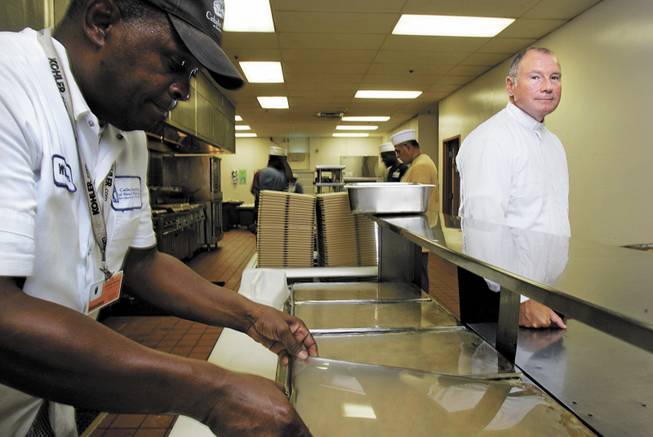
Monsignor Patrick Leary of Catholic Charities says his organization recently switched from chicken breast to thigh meat to save money on food prepared daily in its downtown kitchen, where staff member William Gadson is working Friday.
Monday, Aug. 18, 2008 | 2 a.m.
In 2005, Las Vegas was a boomtown for more than just real estate and gaming.
That year, the metropolitan area saw the greatest growth in charitable organizations of any city in the country except Atlanta. According to the Chronicle of Philanthropy, more than 3,000 groups sprang up, signaling the growing strength of a nonprofit infrastructure that would support causes from the arts to education to children and the elderly.
But with the economic downturn cutting into charitable donations, some who work in the nonprofit sector say the valley might lose some of that hard-gained ground. The lean times may knock out smaller, less established groups that survive fundraiser to fundraiser. Others might have to join forces to make it.
“These economic conditions affect a young community more than an established one,” said Don Snyder, who is leading the effort to build the Smith Center for the Performing Arts, which is being funded by public and private dollars.
Charities large and small have felt the effects.
The Nevada Cancer Institute recently announced it will lay off 50 staffers, citing a drop in donations. Public radio station KNPR, 88.9-FM, ended its summer fundraiser 20 percent short of its goal, even though more people participated than did the year before. And at Catholic Charities, some of the organization’s faithful $25-a-year contributors are now lining up to receive groceries or rental assistance at the group’s downtown offices.
Jim Rogers, chancellor of the Nevada System of Higher Education, who is prospecting for major contributions to the system’s health sciences program, said the economy has had a big effect on donors, even those with the deepest pockets.
“It makes a hell of a lot of difference,” he said. “You have a person who’s worth $5 billion, and the next morning they’re worth a billion.”
Long term, Snyder said, the economic slump is just a blip.
Still, tough times have taken some of the wind out of the sails of the performing arts center project, which will feature a 4.75-acre complex housing the Las Vegas Philharmonic, the Nevada Ballet Theatre and various theater productions.
Smith Center backers have gone to the bank to make up a $70 million shortfall in the nearly $500 million they planned to have in hand by the center’s January groundbreaking.
The Smith Center and the Lou Ruvo Brain Institute, another megaproject, are signs that the city’s philanthropic sector is maturing, said Paul Stowell, a past president of the Business Community Investment Council. Individuals and corporations have put down roots and are investing in the community, he said.
The Brain Institute, which will be housed in the Frank Gehry-designed structure near the arts center, will focus on research and treatment of Alzheimer’s, Parkinson’s and other brain diseases.
Maureen Peckman, chief operating officer of Keep Memory Alive, which runs the Brain Institute, said the group has enough money to weather a fiscal storm. “But to think this climate would last for multiple years would be disconcerting,” she said.
In the short term, however, people might be willing to give more than they would in flusher times because they see the need, said Dan Goulet, who heads the United Way of Southern Nevada.
The group took in 14 percent more during this year’s $12.3 million fundraising campaign than it did last year.
The group’s growth could continue because of Las Vegas’ huge untapped donor pool. In addition to employers who have yet to participate in United Way campaigns, two resorts — Aliante Station and Encore — are set to open this fall with more than 6,000 workers.
However, Goulet said most United Way-funded nonprofit organizations are planning for zero growth next year.
The charitable groups that serve the valley’s poor have been hit hard.
For 67 years, Catholic Charities has sent meals to senior citizens, dished up hot food for the homeless at its downtown center and aided hundreds of immigrants and refugees. A 20 percent cut in county funding, along with the spike in food and fuel costs, has dealt a blow to the group’s finances just as the agency’s clientele has doubled.
The charity is seeing some former members of the middle class — hit by the real estate decline, layoffs and high gas prices — slipping into poverty. Some pull up to the agency in SUVs.
The federal rental assistance the agency administers will be gone by December, halfway through its fiscal year.
To stretch its dollar, the agency has substituted chicken thighs for breast meat in the more than 3,000 meals it serves each day.
Albertsons has begun delivering 30,000 pounds of food that’s past its expiration date but still fresh enough to eat. And a local company has donated more fuel efficient trucks to ferry meals to the elderly.
Catholic Charities’ executive director, Monsignor Patrick Leary, said money left to the nonprofit organization in the wills of longtime supporters, along with increased individual donations, will make up for the lost county funding.
Although things are bleak right now, he said he’s certain that charitable giving in Las Vegas will continue to grow.
“Philanthropic outreach is starting to become a real part of our community,” Stowell said.

Join the Discussion:
Check this out for a full explanation of our conversion to the LiveFyre commenting system and instructions on how to sign up for an account.
Full comments policy